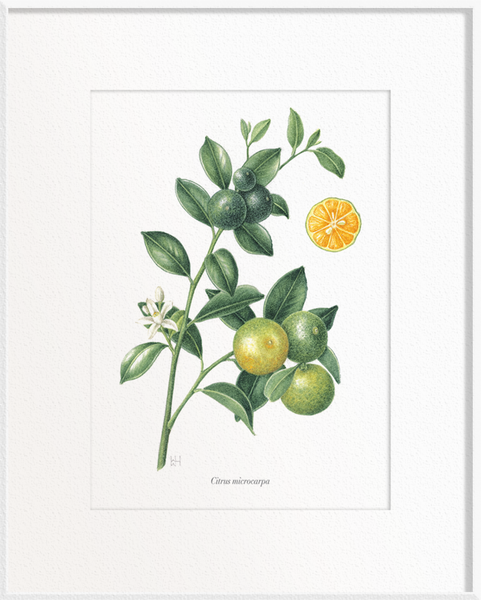Citrus microcarpa (Calamansi/Orange Lime)
Citrus microcarpa, commonly known as calamansi, also known as calamondin or Philippine lemon, is an economically significant citrus hybrid, mainly cultivated in the Philippines. Sometimes called orange lime, it is native to the Philippines and Borneo, as well as southern China and Taiwan. Calamansi is a hybrid between kumquat and another species of Citrus. Genus Citrus refers to the lemon-scented fragrance from the plant, and species microcarpa means small-fruited. Citrus microcarpa is a shrub or small tree growing to 3–6 metres. The fruit resembles a small, round lime, the centre pulp and juice are the orange colour of a tangerine, and the orange peel is very thin when ripe. The fruit itself is quite sour, but the peel is sweet. It is ubiquitous in traditional Filipino cuisine and is used in various condiments, beverages, dishes, marinades and preserves. It is also used as an ingredient in Malaysian and Indonesian cuisines. Citrus microcarpa is high in vitamin C and the juice is used to relieve coughs and colds.
°°°°°
Specifications:
Paper
100% Cotton based, 320g, Acid-free, No optical brighteners.
Printed Area
A4, 210mm x 297mm – Approximately 142mm x 210mm
A3, 297mm x 420mm – Approximately 230mm x 319mm
About the Collection
The Garden of Miss Joaquim Collection: Illustrated Botanical Prints
Agnes Joaquim was a Singapore-born Armenian who created what would become Singapore’s National Flower, the Vanda Miss Joaquim (scientific name: Papilionanthe Miss Joaquim), in 1893. The artificial hybrid was recognised by the first director of the Singapore Botanic Gardens, botanist Henry Ridley.
Agnes, the first woman in the world to create a hybrid orchid, was a well-known and successful horticulturist, garnering 70 horticultural awards from 1881 to 1899. The Garden of Miss Joaquim Collection of botanical prints commemorates her horticultural legacy and complements her story told in the book Agnes and Her Amazing Orchid.
In presenting Agnes’s award-winning plants in the illustrated collection, we looked at the newspaper records of the times, but they were of no use because they used common name descriptions of the plants, such as ‘rose’ and ‘durian’. So we turned to the Singapore Botanic Gardens and collaborated with a botanist to identify the likely species. To complete Agnes’s story, the collection includes two additional images: of Vanda Miss Joaquim’s parents, Papilionanthe teres (pod parent) and Papilionanthe hookeriana (pollen parent) — formerly in the genus Vanda — both of which may have been present in her award-winning floral bouquets or cut flowers. Waiwai Hove, a talented and respected botanical illustrator, was chosen to produce the prints.
*Disclaimer: Representative only based on subject. Not species definitive.
About the Illustrator
Born in Kuala Lumpur, Malaysia, Waiwai Hove developed a love for nature from a young age. Growing up surrounded by rich tropical flora and nurtured by her mother, a keen gardener, Waiwai has always held a special place for plants in her childhood memories. She holds a diploma in botanical illustration from the Society of Botanical Artists (UK), graduating in 2013 with a distinction and the highest marks in the history of the course.
She has since worked for the Singapore Botanic Gardens, where highlights include illustrations for ‘30 Heritage Trees’ and more recently ‘15 Gingers’. Four of Waiwai’s ginger paintings were subsequently used for a series of stamps issued by Singapore Post in 2018. Since 2019, Waiwai has begun working on the cover illustrations of 14 volumes of The Flora of Singapore, to be published over the next few years. Her works are in numerous private collections and can also be found in publications by the National Parks Board and in the Shirley Sherwood Collection in Kew Gardens, UK.




